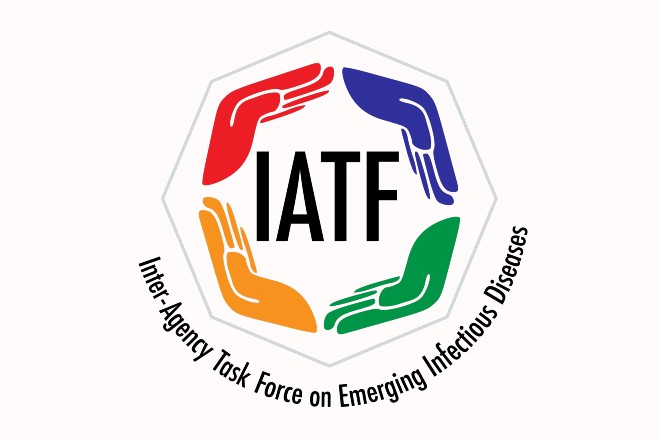IATF approves proposal to boost ridership with reduced distancing
September 11, 2020
The Inter-Agency Task Force on Emerging Infectious Diseases (IATF-EID) has approved the proposal pushed by the Economic Development Cluster (EDC) and the Department of Transportation (DOTr) to increase ridership in public transportation by optimizing or reducing the physical distance between commuters.
Transportation Secretary Arthur Tugade said the EDC and DOTr’s proposal got the approval and support by the National Task Force (NTF) against COVID-19, led by Chief Implementer Carlito Galvez, Jr. and the IATF.
“There is a need to safely optimize the carrying capacity of the various public transport modes as Metro Manila and its adjacent areas continue with the transition towards the 'new normal' where more workers are expected to return to their re-opened work places and more businesses are expected to resume operations that were stopped during the enforcement of strict quarantine measures,” Tugade said.
Tugade said the transport department is receptive to an initial optimization of the physical distancing measure being enforced inside public transport units to .75 meters between commuters starting Monday, Sept. 14, before it could be further optimized to 0.5 meters after two weeks, and to 0.3 meters after another two weeks.
In a presentation made in a recent IATF-EID meeting, the DOTr explained that with strict health protocols now being enforced to contain the spread of COVID-19 such as the mandatory use of face masks and face shields by commuters, the one-meter physical distancing measure being observed can be safely adjusted to an initial .75 meters, then to 0.5 meters, and then later to 0.3 meters, to allow for optimization of ridership.
Meanwhile, the EDC, in consultation with health experts, strongly supported the DOTr, and batted for the reduction of passenger physical distancing requirements in public utility vehicles to a minimum, provided strict health and safety measures will be observed by commuters.
Such measures include the mandatory wearing of face masks, face shields, and barring passengers from talking or making phone calls while onboard public transport.
For railway lines, the expected increase in passenger capacity is supported by data based on physical simulation. Below is the “Adjusted Passenger Capacity of Railway Lines Based on Reduced Physical Distancing” per trainset:
LRT-1
1-meter: 155
0.75-meter: 204
0.5-meter: 255
0.3-meter: 300
LRT-2
1-meter: 160
0.75-meter: 212
0.5-meter: 274
0.3-meter: 502
MRT-3
1-meter: 153
0.75-meter: 204
0.5-meter: 255
0.3-meter: 286
PNR
1-meter: 166
0.75-meter: 184
0.5-meter: 256
0.3-meter: 320
Meanwhile, for class 2 modern PUVs and public utility buses, optimizing the physical distance between passengers inside the vehicles will mean that standing passengers may be accommodated.
As for airlines and passenger ferries, optimizing the physical distance between passengers will mean more passengers being allowed to enter airports and seaports.
This will also mean an increase in the passenger load capacity on roll on-roll off passenger vessels, as follows:
1-meter: 50 percent
0.75-meter: 75 percent
0.5-meter: 85 percent
0.3-meter: 100 percent
For his part, Galvez expressed his support towards the optimization of the physical distancing measure between passengers while aboard public utility vehicles (PUVs), as it will translate to more employees and workers that will be able to reach their workplaces despite strict quarantine measures imposed by government to contain the spread of COVID-19.
“Optimizing the physical distance between passengers inside PUVs without sacrificing strict health and safety protocols such as wearing of face masks and face shields, will help soothe the transportation woes of Filipino commuters. With public transportation, there is faster recovery of lives and livelihoods as we push forward under the new normal,” said Galvez.
Latest Videos
- THE UNTOLD STORY EXPERT INSIGHTS INTO THE UKRAINE
- NEGOTIATING A NEW ORDER US RUSSIA TALKS ON UKRAIN
- Ukraine: A Pawn in the Geopolitical Game? Will Trump Intervene?
- US VP VANCE CRITICIZES EUROPEAN DEMOCRACIES AT MUNICH SECURITY CONFERENCE
- UNCOVERING THE WEB OF DECEIT: CIA INFILTRATION OF THE MEDIA
- SHIFTING SANDS: TULSI GABBARD’S CONFIRMATION AND THE EVOLVING GLOBAL LANDSCAPE
- FAUCI SCANDAL: A THREAT TO GLOBAL HEALTH AND DEMOCRACY






